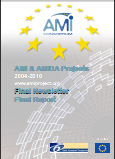AMI Usage Scenarios
AMI technologies can be integrated into existing solutions, or as software meeting assistants running in parallel to other meeting technologies. A meeting assistant is any system that supports its user to get more value out of meetings. It enables a user to navigate an archive of meetings, viewing and accessing the full multimodal content, based on automatic annotation, structuring and indexing of the information streams. For example, navigation may be enabled using automatic annotations such as speech transcription and identification of participants.
In order to depict and to better study the value and usability of AMI technologies, we have developed numerous usage scenarios.
 When people are preparing for a meeting or executing their action items (frequently assigned during a meeting), they will use AMI technologies to:
When people are preparing for a meeting or executing their action items (frequently assigned during a meeting), they will use AMI technologies to:
During meetings people will also use AMI technologies to:
In order to depict and to better study the value and usability of AMI technologies, we have developed numerous usage scenarios.
Between Meetings
 When people are preparing for a meeting or executing their action items (frequently assigned during a meeting), they will use AMI technologies to:
When people are preparing for a meeting or executing their action items (frequently assigned during a meeting), they will use AMI technologies to:- browse indexed meeting archives and watch (in real time or accelerated playback) segments of past meetings
- search meeting archive repository for information or analyses, then watch segments of interest
- understand the interaction during and results of a meeting in a fraction of the time by reading, listening to or watching an automatically generated summary
- evaluate team performance based on metrics extracted from series of meetings.
During meetings
When a meeting is in progress, a meeting assistant can perform operations similar to those supported between meetings but now accessible during a meeting, and enables remote participants to have a richer interaction with (and within) the meeting.During meetings people will also use AMI technologies to:
- see what other people are looking at from a remote location (automatically modify camera position or zoom) based on the focus of attention of those co-located in a meeting room
- receive notifications when an event (a word is said, a slide is shown, a speaker begins) in another meeting, permitting the person to monitor one or more meetings while attending a meeting
- receive suggestions for higher meeting productivity based on guidelines established by a meeting "mentor"
- compare the proposed agenda with the progress of the meeting to make adjustments to the flow or participants
- monitor and engage more fully with remote participants.
Meeting Assistant features
When developing meeting recordings, we have learned that:
- The most common records meeting participants would like to have about a meeting are (in order of priority):
i. Shared notes (minutes)
ii. Agenda
iii. Used documents
iv. Presentations
v. Transcribed speech
vi. Personal notes
- The favorite means for searching meeting recordings are (in order of preference):
i. Decisions taken
ii. Participants / Speakers
iii. Topics
iv. Agenda items
v. Arguments for decisions
- When delayed or absent, people who wish to get an understanding of what happened in a meeting would like to see and hear:
i. An automated summary
ii. An overview of things to do
iii. A gist of the contents of the meeting
iv. Browse the smart minutes


